Two emperors, roughly 2000 years ago, supervised the creation of their own burial treasures before they died. One (called Qin Shi Huang) created an entire pottery army, in formation, with infantry, cavalry, chariots, archers and a command section. The other (called in various places Han Jing, Liu Qi, or Jindi, I can’t quite work out his name) created pigs, horses, goats, carts, pots, peasants, managers of food supply and representations of judicial functions. Han Jing the yin to Qin Shi’s yang. Which would you take?
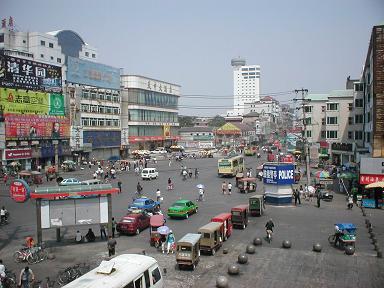
Rosemary and I have just taken a lolloping rail route from Shanghai round past the Yellow river in northern China. We passed through Kaifeng – still with bicycles, men playing chess, puppy dogs for sale in the street in cages, OK tourist attractions. The photo of the square by day above, after dark turns into a night market, with hundreds of food stalls selling freshly grilled kebabs, stir frys, geletinous desserts from elephant kettles, freshly rolled filled pastas and thousands of people.
Then Luoyang. In the cliffs of a river near Luoyang, Buddhist emperors and empresses had Buddhas as high as 15 story buildings carved deep into the face of the rock. The photo on the left below is of the river Yi nearby, and the photo on the right of a Heavenly Warrior. Bigger than he looks, 15m tall I think.
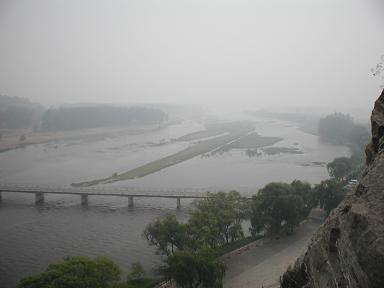
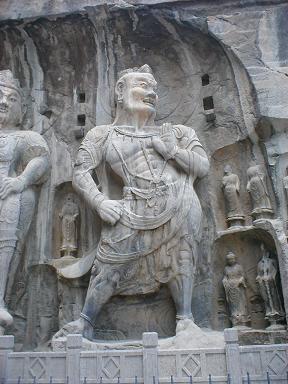
We’re in Xi’an at the moment, site of numerous ancient capitals of China. It’s in terms of development all that I had expected Shanghai would be. It feels wealthy, with valuable cars. But it’s also just that bit cleaner, and more relaxed than Shanghai. Bell Tower Square at night feels like an evening square in Italy, well dressed people enjoying the balmy night. The old city walls are still complete, and together with the gardens where the moat used to be form both a landmark and a sense of space.
“These tiles are clean! I wonder if the plaza there pays for them to be scrubbed every day?” “Oh no, it’s because they’re brand new, look even though it’s the evening, the workmen are still laying them.” I was shy about photographing them, but once I did they all started posing with their shovels (photo below left). It looked somewhat ad hoc.
It seems that if you dig a hole more than few metres deep, you’ll stumble upon buried treasure anywhere in Shaanxi province. The cute little lamb on the right is a couple of thousand years old, and was recently found by the Xian Lightbulb Corporation during construction of a new building.
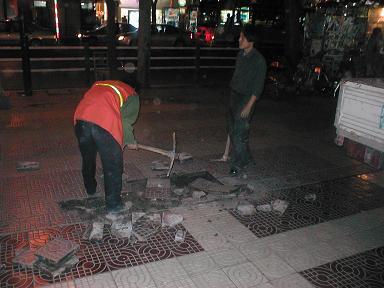
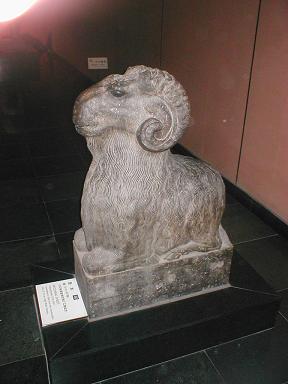
And those two emperors, planning for their afterlives?
The famous Terracota Warriors, found accidentally by peasants digging a well in the mid 1970s, were the treasures of the first yang emperor, Qin Shi. Well worth going to – make sure you see the movie there, which was filmed with a 360 degree camera and gives more useful historical information than the broken English signs. The surprise hit (found via the most recent Lonely Planet, and only discovered at all in the early 1990s) is Han Yangling, the mausoleum of the second emperor, Han Jing. It’s in many ways more fascinating than the Warriors. Much less busy, with time and space to linger. Glass floors going above burial pits, you can see the excavations of all the animals and people close up.
It’s difficult to decide which emperor I’d follow while preparing my afterlife. It’s much more in my character to follow Han Jing, and take enough peasants, animals, equipment and administrative functions to form a new civislisation. But, alas, I know that Qin Shi’s pottery invasion force would plunder it all as soon as we got there. So, on balance, I’d have to defect in this prisoner’s dilemma, and take the army.
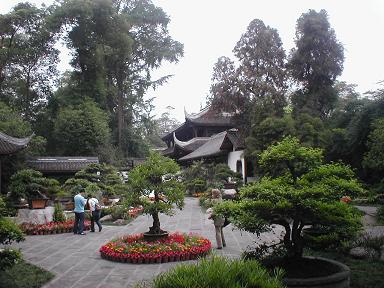 If you fall off the eastern edge of the Himalayan mountains, the first major city (population 4.1 million) that you come to is Chengdu, in China’s Sichuan province. You’ve heard of it from the spicy Chinese food, called “Szechuan” in the west.
If you fall off the eastern edge of the Himalayan mountains, the first major city (population 4.1 million) that you come to is Chengdu, in China’s Sichuan province. You’ve heard of it from the spicy Chinese food, called “Szechuan” in the west. 




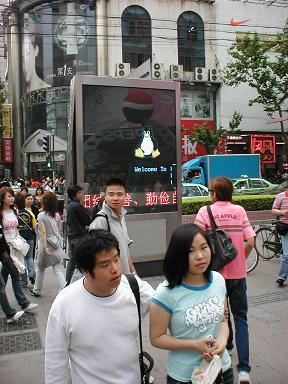
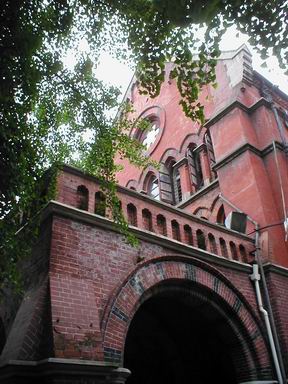 Almost as soon as we got off the plane on Wednesday, Rosemary (my mum) dragged me from the tourist trap of the Bund, into some overcrowded, grimy backstreets hunting for the derelict cathedral where her parents were married and she was christened. The magnetic levitation train from Pudong Airport was great fun – not because it travelled at 431 km/h, the fastest train in the world, but because at some points the earth around us seemed to rotate at what felt like, but could not have been, an unnerving 45 degrees. It turned out that we were tilting, but so exactly as we cornered that you couldn’t feel any force.
Almost as soon as we got off the plane on Wednesday, Rosemary (my mum) dragged me from the tourist trap of the Bund, into some overcrowded, grimy backstreets hunting for the derelict cathedral where her parents were married and she was christened. The magnetic levitation train from Pudong Airport was great fun – not because it travelled at 431 km/h, the fastest train in the world, but because at some points the earth around us seemed to rotate at what felt like, but could not have been, an unnerving 45 degrees. It turned out that we were tilting, but so exactly as we cornered that you couldn’t feel any force.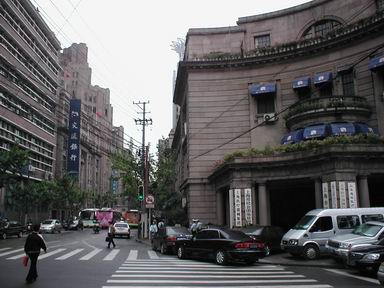 We also found the old council building (photo left), and nosed inside. It’s lucky that the guards are friendly now, as it seems Rosemary won’t let any fear stop her from access to family history. It was grand inside, and there were lots of old framed photos of the building under construction, and of speeches from the balcony (see photo) to celebrate when the Communists took over rule of the city in 1949. My grandfather worked in here. He did lots of different things, mainly to do with water pollution, but also, for example, helping to develop tarmac suitable for the local weather.
We also found the old council building (photo left), and nosed inside. It’s lucky that the guards are friendly now, as it seems Rosemary won’t let any fear stop her from access to family history. It was grand inside, and there were lots of old framed photos of the building under construction, and of speeches from the balcony (see photo) to celebrate when the Communists took over rule of the city in 1949. My grandfather worked in here. He did lots of different things, mainly to do with water pollution, but also, for example, helping to develop tarmac suitable for the local weather.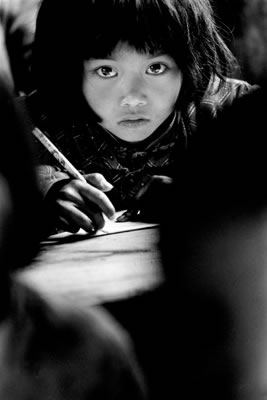 A week on Tuesday I’m going to China again. Starting in Shanghai, which is on the East coast in the centre, at the mouth of the Yangtze river. I’m travelling with Rosemary, my mum (who I spent a few weeks with in Japan three years ago; see the last few articles
A week on Tuesday I’m going to China again. Starting in Shanghai, which is on the East coast in the centre, at the mouth of the Yangtze river. I’m travelling with Rosemary, my mum (who I spent a few weeks with in Japan three years ago; see the last few articles 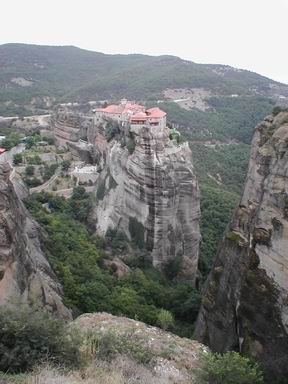 Just a quick post, as internet access is expensive here. Or at least it feels expensive as you have to put coins in a slot. I’m in Kalambaka towards the north of Greece. The attraction here are the impressive Meteora, huge pillars of rock topped by 14th century monastries.
Just a quick post, as internet access is expensive here. Or at least it feels expensive as you have to put coins in a slot. I’m in Kalambaka towards the north of Greece. The attraction here are the impressive Meteora, huge pillars of rock topped by 14th century monastries. 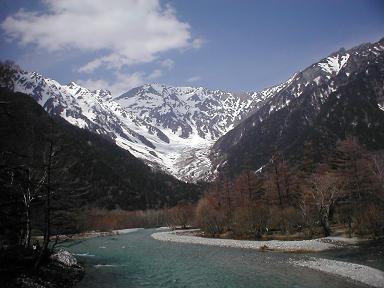 When I was a child there was only one thing considered more dangerous than taking sweets off strangers. It’s so ingrained in me by the ambient protection of society not to hitch hike that I have never even considered doing it. All sorts of unclarified bad things might happen. For example, people might have conversations with other people that they didn’t know already, or (gasp!) who belong to a different social class. Perhaps, like in China, people might learn to start paying each other for lifts, thus creating a more efficient and more capitalist transport economy, with the added side effect of being better for the environment. The consequences both for society, and in increasing everyones standard of living, could have no end of positive implications.
When I was a child there was only one thing considered more dangerous than taking sweets off strangers. It’s so ingrained in me by the ambient protection of society not to hitch hike that I have never even considered doing it. All sorts of unclarified bad things might happen. For example, people might have conversations with other people that they didn’t know already, or (gasp!) who belong to a different social class. Perhaps, like in China, people might learn to start paying each other for lifts, thus creating a more efficient and more capitalist transport economy, with the added side effect of being better for the environment. The consequences both for society, and in increasing everyones standard of living, could have no end of positive implications.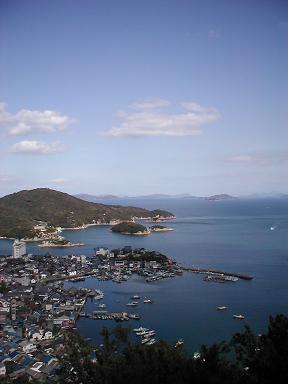 Japan has a sea with no waves, where only narrow connections to the vast Pacific add salt and stop us calling it a lake. It’s an enchanting place, the distinctive shape of the islands a familiar romantic myth from much Japanese art. Rosemary and I spent much of last week travelling from Kansai along the north coast of the sea to Hiroshima and back. This picture is taken from a hillside temple at the fishing port of Tomo no Ura; it gives a good feel for the dramatic but cosy views across the sea in the sun. Even better was the Sete Ohashi bridge which we crossed on a day trip to Takamatsu. It was a dreadful foggy day, and all we could see from the train was white mist with peaks of the islands coming in and out of view. Only seeing the tops made them all the more mystical in shape.
Japan has a sea with no waves, where only narrow connections to the vast Pacific add salt and stop us calling it a lake. It’s an enchanting place, the distinctive shape of the islands a familiar romantic myth from much Japanese art. Rosemary and I spent much of last week travelling from Kansai along the north coast of the sea to Hiroshima and back. This picture is taken from a hillside temple at the fishing port of Tomo no Ura; it gives a good feel for the dramatic but cosy views across the sea in the sun. Even better was the Sete Ohashi bridge which we crossed on a day trip to Takamatsu. It was a dreadful foggy day, and all we could see from the train was white mist with peaks of the islands coming in and out of view. Only seeing the tops made them all the more mystical in shape.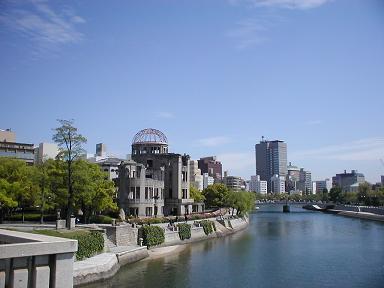 The politcally correct question to debate at this point is whether the US was justified in using it. This is besides the point – the functioning of the war machine of a country made its use inevitable. One argument goes that ending the war quickly and with less total loss of life was the motive, but I feel that was just a side issue. More important was to test this new device in real action, and to show the world just how strong the US had become. Would any functioning military, a structure by its very nature designed to kill, surprise, shock and awe, really have missed this opportunity? Was the
The politcally correct question to debate at this point is whether the US was justified in using it. This is besides the point – the functioning of the war machine of a country made its use inevitable. One argument goes that ending the war quickly and with less total loss of life was the motive, but I feel that was just a side issue. More important was to test this new device in real action, and to show the world just how strong the US had become. Would any functioning military, a structure by its very nature designed to kill, surprise, shock and awe, really have missed this opportunity? Was the